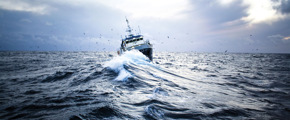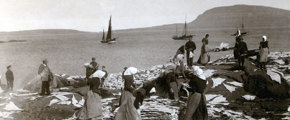Redfish
The redfish is part of the Scorpaeniform order, also called ray-finned fish, giving them their signature look. They have an attractive red colour, hence the name, which encompasses several different varieties. The Faroe Islands mostly fish the golden redfish (Sebastes marinus) and the deepwater redfish (Sebastes mentella).
Redfish has a mild and sweet taste that works well with herbs, spices and different flavours. This means that redfish is exceedingly versatile and can be easily cooked, grilled and fried with nearly any kind of marinade.
Living in the cold waters of the Arctic and North Atlantic, the redfish will grow and mature slowly, giving the meat a deliciously dense texture, full of moisture. Even though redfish can be prepared in similar ways to other whitefish, the firmness and moisture of the meat makes it ideal for grilling and frying.
Redfish is particularly good to fry over high temperatures, blackening the meat. Marinating the fish with some spices, herbs and dressing beforehand will personalise the dish to individual tastes.
The redfish contains a lot of proteins and healthy Omega-3 fatty acids. It also has a good amount of vitamin B12 and Selenium.
Biology
There are several different types of redfish found in the North Atlantic, but the Faroese fish nearly exclusively for golden redfish (Sebastes marinus) and the deepwater redfish (Sebastes mentella).
In the Faroe Islands redfish is called Kongafiskur (Kingfish) - the golden redfish Stóri kongafiskur (Big redfish) and the deepwater redfish Trantkongafiskur (Muzzle redfish).
The redfish is easily identifiable due to its distinctive appearance with characteristic large, protruding eyes, sharp defined gills, a pouty mouth and attractive red colour.
The golden redfish has more of an orange tinge to the skin. The colour is graded, but changes sharply into a white stomach.
The deepwater redfish has a more solid red colour with a smoother transition to a white stomach.
The golden redfish can grow up to 100 cm in length but will normally be around 40 to 55 cm long. The deepwater redfish can grow up to 70 cm in length but is normally 35-45 cm.
Redfish have one long dorsal fin, with hard spikes in towards the front. The posterior fin has a few of these spikes as well. The pelvic fin is small in size, but the pectoral fins are large and rounded.
Redfish is a demersal fish that prefers cold waters and a rocky seabed, making the North Atlantic ideal. They mostly eat plankton, but the mature redfish will eat other fish. They can be found at various depths, ranging from 100 metres to 1000 metres. The golden redfish is common at depths of 100-500 metres while the deepwater redfish will normally keep below depths of 450 metres.
The female is inseminated, and the young are live born. They are quite slow to mature, not reaching sexual maturity until between 12 and 15 years. Newly spawned redfish will keep close to the ocean surface until they are around 25 millimetres long, when they head out to deeper waters.
They can be found around the eastern coast of Greenland, across the North Atlantic and around the Faroe Islands, along the Norwegian coast and up to the Barents Sea.
The Faroese mostly fish for redfish in Faroese waters, but do also fish in international areas of the North Atlantic, such in the Norwegian Sea and the Irming Sea. Faroese vessels mainly use trawl and longline to fish for redfish.

(Sebastes Marinus)




